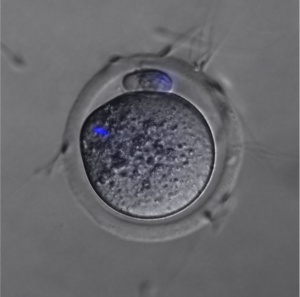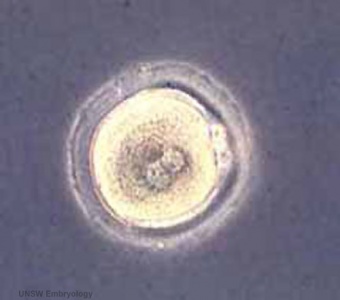Foundations Practical: Introduction | Week 1 and 2 | Week 3 and 4 | Week 1 to 8 | Week 9 to 36 | Neonatal | Critical Periods | Additional Resources | Quiz
Fertilization and Blastocyst Development
- The menstrual cycle dictates timing of fertilization and implantation and therefore when life can begin.
Development starts before fertilization with the release of the egg (oocyte) from the ovary (ovulation). This process along with preparation of the uterus for implantation is an endocrine controlled cycle, the menstrual cycle.
This first page will give a brief overview of: menstrual cycle, fertilization, blastocyst and implantation. You are not expected to know everything about these processes, just keep track of the relative "timings" as to when specific processes occur.
Ovulation
Menstrual Facts
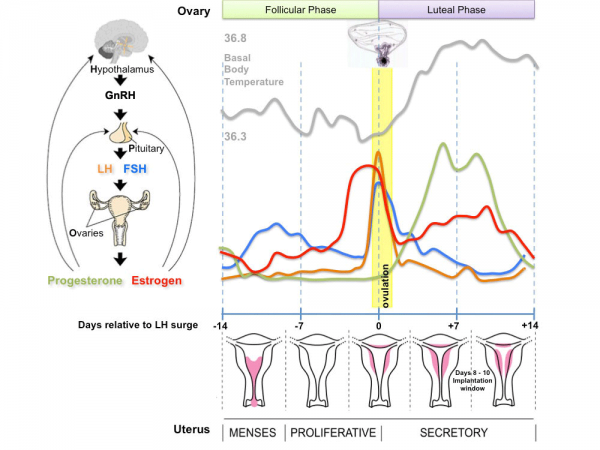
- The average menstrual cycle is 28 days with ovulation (egg release) occuring approximately the middle of the cycle.
- The last menstrual period is used clinically in determining developmental ages.
- Menstruation phase (period) is the loss of the uterus epithelial functional layer and occurs if fertilization and implantation has not occurred before the end of the current cycle.
Fertility Window

Probability of women with regular or irregular cycles being in their fertile window
|
Clinical guidelines have typically identified the "fertile window" between days 10 and 17 within the typical 28 day menstrual cycle.
Data from a large USA NIEHS (1982-86) identified the timing of the “fertile window” within a range of different menstrual cycles.
- fertile window occurred during a broad range of days in the menstrual cycle.
- between days 6 and 21 women had at minimum a 10% probability of being in their fertile window.
- women cannot predict a sporadic late ovulation; 4 - 6% of women whose cycles had not yet resumed were potentially fertile in the fifth week of their cycle.
- in about 30% of women is the fertile window entirely within the days of the menstrual cycle identified by clinical guidelines (between days 10 and 17)
- women should be advised that the timing of their fertile window can be highly unpredictable, even if their cycles are usually regular.
|
Fertilization

|
Fertilisation to
4 Blastomere
|
| Page | Play
|
|
|
Week 1 and 2
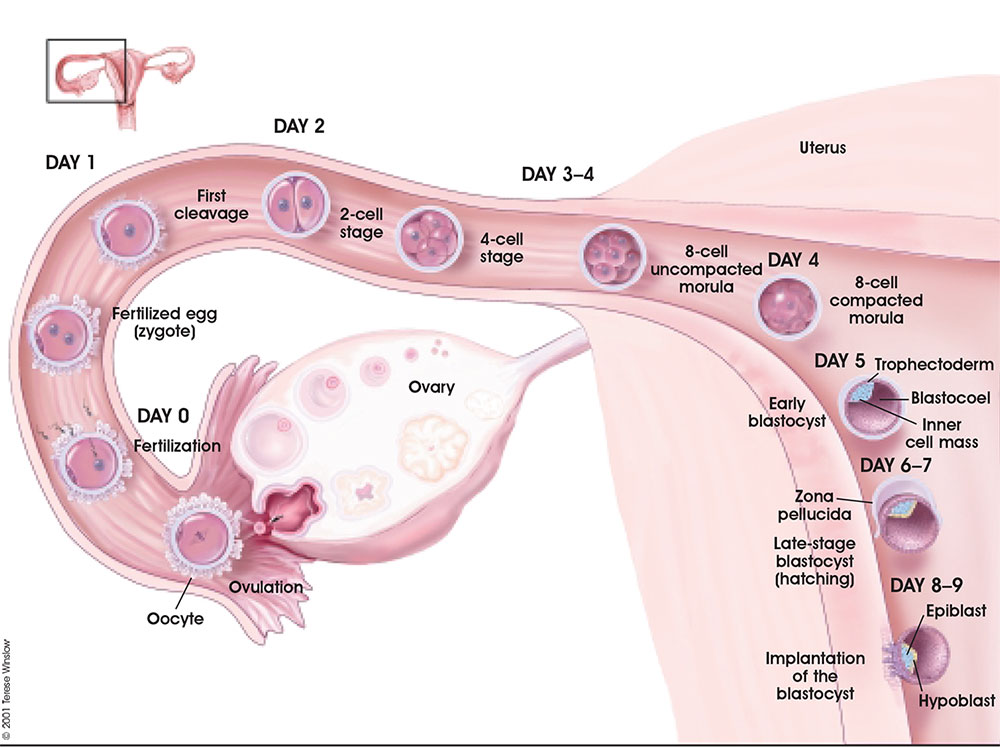
Week 1 Movies
Pregnancy Test

Pregnancy Test
| Ovary and Corpus Luteum Anatomy
|
Ovary and Corpus Luteum Histology
|
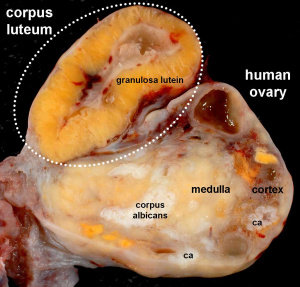
|

|
Additional Information
|
|
Where I use the sub-heading "Additional Information" in class materials, it is just that, not part of the class but useful in helping your understanding of the class concepts. I generally include the disclaimer shown below on the class page.
|
| Additional Information - Content shown under this heading is not part of the material covered in this class. It is provided for those students who would like to know about some concepts or current research in topics related to the current class page.
|
Take the Quiz
Open the table below, select your answers, click submit, then reopen the table to see your result.
Gamete Formation
Oogenesis and Spermatogenesis are the processes of haploid gamete formation by meiosis. If you have some time in the Lab also have a look at these topics and the gonad structure. These topics will be revisited in detail in BGDA.
Movement in the Uterine Tube
| <html5media height="280" width="600">File:Mouse trachea 01.mp4</html5media>
|
| The oocyte, zygote, morula, blastocyst floats in uterine secretions and is moved by the ciliated epithelium, similar to the mechanism seen in the movement of mucus by the trachea ciliated epithelium.
|
Terms
Note - linked terms in the list below are external resources to the current class content.
- azoospermia - (ICD-11 GB04.0) Any condition of the genital system affecting males, caused by obstruction of the reproductive tract, abnormal hormone levels, testicular failure, or inadequate production of spermatozoa. Characterized by the absence of a measurable level of sperm cells in semen, and very low levels of fertility. Confirmation is by the absence of spermatozoa in the sediment of a centrifuged sample of ejaculate.
- blastocyst - (Greek, blastos = sprout + cystos = cavity) Term used to describe the hollow cellular mass taht forms in early development. In humans, this stage occurs in the first and second weeks after the zygote forms a solid cellular mass (morula stage) and before implantation. The blastocyst consists of cells forming an outer trophoblast layer, an inner cell mass (embryoblast) and a fluid-filled cavity. The blastocyst inner cell mass is the source of true embryonic stem cells capable of forming all cell types within the embryo.
- cervix - (Latin, cervix = neck) The female anatomical region of the uterus forming a canal that opens and connects to the vagina.
- conceptus - The entire product of conception, that is all the structures derived from the zygote and includes not only the embryo, but also the placental and membrane components.
- fundus - top part of the uterus body formed by the region lying between the two uterine tubes. A common implantation site.
- gonad - (Greek, gonos = seed) A gamete-producing (germ cell) organ. A non-sexual term which is used to describe both the female ovary and male testis.
- hCG - An acronym for the hormone human Chorionic Gonadotrophin.
- human Chorionic Gonadotrophin - (hCG) Placental hormone initially secreted by cells (syncitiotrophoblasts) from the implanting conceptus during week two, supporting the ovarian corpus luteum, which in turn supports the endometrial lining and therefore maintains pregnancy. Hormone can be detected in maternal blood and urine and is the basis of many pregnancy tests. Hormone also stimulates the onset of fetal gonadal steroidogenesis, high levels are teratogenic to fetal gonadal tissues.
- implantation - The term used to describe process of attachment and invasion of the uterus endometrium by the blastocyst (conceptus). Abnormal implantation is where this process does not occur in the body of the uterus (ectopic) or where the placenta forms incorrectly.
- pronuclei - The male spermatozoa and female oocyte haploid nuclei located in the early zygote before they fuse to form the diploid nucleus.
- uterus - The female internal genital (reproductive) tract forming a hollow muscular walled organ, embryonically derived from the paramesonephric ducts. The human uterus has two uterine tubes or horns (fallopian tubes) where the first week of development occurs and a single hollow body where implantation of the blastocyst normally occurs. Following puberty, the non-pregnant uterus (epithelium and underlying stroma) undergoes cyclic changes under the influence of hormones, the menstrual cycle. This cycle of uterine changes ceases during pregnancy and it contributes the maternal component of the placenta.
Foundations Practical: Introduction | Week 1 and 2 | Week 3 and 4 | Week 1 to 8 | Week 9 to 36 | Neonatal | Critical Periods | Additional Resources | Quiz
Glossary: A | B | C | D | E | F | G | H | I | J | K | L | M | N | O | P | Q | R | S | T | U | V | W | X | Y | Z | Numbers
Cite this page: Hill, M.A. (2024, April 30) Embryology Foundations Practical - Week 1 and 2. Retrieved from https://embryology.med.unsw.edu.au/embryology/index.php/Foundations_Practical_-_Week_1_and_2
- What Links Here?
- © Dr Mark Hill 2024, UNSW Embryology ISBN: 978 0 7334 2609 4 - UNSW CRICOS Provider Code No. 00098G
